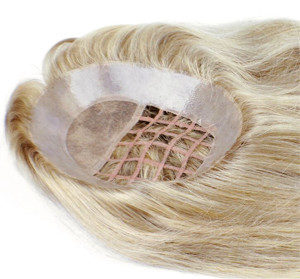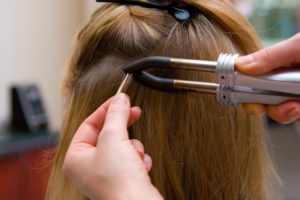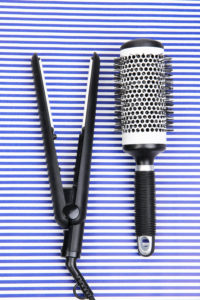Long gone are the days when hair extensions were only seen on red carpets and music videos. Now, you can have access to longer, thicker hair and it’s easier than you think.
From clip-in extensions to micro-link, how do you even know where to start? Whether you want to add a few inches or thicken up your thinning locks, there is a hair extension method that will fit your needs!
Below we have the ultimate hair extension guide to help you along the way to your journey for new and improved hair.
Your Ultimate Guide to Everything Hair Extensions
But I thought hair extensions were just for length?
Hair extension technology has come a long way from when you used to be able to spot if a woman was wearing ‘fake’ hair. High-quality hair extensions blend beautifully with your hair and have become a solution for every hair issue imaginable.
Typical hair extension methods, including clip-in, tape-in, micro-link, and keratin bond are great ways to add length, thickness, and pops of color. A full-length application will give you both thickness and length, whereas if you just need thickness, you can add a few panels or wefts on the sides of your hair. If you have been wanting to highlight your hair but haven’t been able to commit, adding hair extensions are a perfect way to experiment. You can add peek-a-boo highlights or even a full ombre without damaging your natural hair with bleach.
 Let’s not forget about the top of the head, which is a commonplace men and women experience hair loss or thinning. There are various top of the head pieces available on the market that can be applied using clips or even semi-permanent methods.
Let’s not forget about the top of the head, which is a commonplace men and women experience hair loss or thinning. There are various top of the head pieces available on the market that can be applied using clips or even semi-permanent methods.
easihair pro recently launched Revive, a revolutionary top of the head piece that uses a reverse tape-in method and can last 6-8 weeks before you will need a reapplication. Most top of the head pieces available on the market require shaving of the head. Revive is the first semi-permanent solution for hair loss that can be applied to your natural hair without any shaving.
Why do I need hair extensions?
There are many benefits to wearing hair extensions. However, many women turn to hair extensions as a solution if they can’t grow their hair to the desired length or thickness naturally. Hair has become part of many women’s identities and can be a major insecurity.
Hair extensions aren’t only for those who want to have extra hair 24/7. Clip in extensions are a quick way to make you feel like you have a glam squad for a wedding or special occasion.
Did you get a haircut and absolutely hate your choppy layers? Add in a few panels or wefts to quickly fix the issue while your hair grows back to normal.
As long as you are purchasing high-quality hair extensions from a certified stylist and following the proper care and maintenance, you will not damage your hair in the process.
What are the different hair extension methods?
Finding a hair extension method that works best for you can be challenging, especially if you’re completely
new to hair extensions. Aside from wigs and hairpieces, there are four main attachment methods that you can choose from, including strand by strand, weft, clip in extensions and micro-link skin weft.
Strand by strand extensions is extensions that are applied individually using glue or micro-links. This form of hair extensions are durable and last a long time. However, the application time can range anywhere from 4-6 hours. Also, strand by strand is one of the most expensive hair extension methods since it is long-lasting.
Weft hair extensions include tape in extensions, glue-in, and sew-in/braided. Tape in extensions has quickly become one of the methods most used by stylists due to the quick application time without the use of any heat or tools. Hair will need a reapplication about every 6-8 weeks and can be reused multiple times. After application you can’t shower for 24-48 hours, which may be an issue if you’re active.
Glue-in extensions are considered a short-term method because the glue only lasts a few days. Perfect for someone who only wants to wear extensions for a few days at a time, because this type can be the least expensive.
Sew-in or braided extensions are most suitable for thick and coarse hair. The application can take several hours and can cause discomfort for some clients. Also, tight braids over time can cause tension or traction alopecia.
Which method is best for me?
Take into consideration your hair health, hair type and texture, and your budget before choosing a hair extension method. Take a look at the hair extension methods page for detailed information on pros and cons.
Cosmetology school does not have courses related to hair extensions that students must take before they can become licensed. Many hair extension brands offer education with their products. Make sure your stylist is certified with your hair extensions before committing to a service. Schedule a consultation beforehand if you are unsure about which method is best for your hair and lifestyle.
What about Remy hair? Does it matter?
Unless you want tangled, dull hair extensions, then pay close attention to the quality of hair you’re purchasing. If you’re even slightly familiar with hair extensions, then you’ve come across the term “Remy.” Remy means that when the hair is collected, the strands of the hair remain in the same direction with the cuticle intact, which keeps the hair shiny and tangle free.
Remy hair has become a term that hair extension companies have attached to their product to offer a cheap product for an expensive price. However, most of these companies do not have Remy hair or even 100% human hair. Purchase hair extensions from a reputable source to make sure you are actually buying a high-quality product.
Quick hair extension care tips!

- Brush your hair at least three times a day to keep your hair shiny and knot-free. We recommend keeping a brush in your purse as a reminder throughout the day.
- Always braid your hair before bedtime to keep your hair tangle-free.
- Depending on the method, you can shampoo as normal, but never apply conditioner near the base. Any oils or silicones may compromise the bond and slipping can occur.
- Whether you have extensions or not, apply a thermal protectant before you use any hot tools, including flat iron and blow dryer. This will not only protect your hair from frizz but from any thermal damage that can occur over time with the frequent use of hot tools.
- Anytime you experience an issue, contact your stylist! Never try a DIY quick fix that you found on Google.
Kristie Karmah
Love this article! All about the quality sourced hair…and the methods used to implement. I wrote a piece that might compliment this great guide, http://bit.ly/2joSL5z , hope you enjoy 🙂